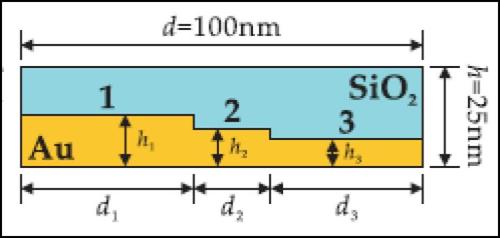Skip to comments.
How to Make Light Go Faster
Scientific Computing ^
| 5/13/2013
| Ann R. Thryft
Posted on 05/14/2013 7:36:35 AM PDT by null and void
Researchers at the Missouri University of Science & Technology have designed a new nanoscale material that can transmit light -- at least its phase front -- faster than the 186,000 miles per second it usually takes to go through air.
That speed through air, or through the vacuum in outer space, is what we usually think of as the speed of light. But light travels at different speeds depending on the material it is passing through. The metric for expressing this difference is the effective permittivity of light: the ratio of light's speed through air to its speed when passing through another material. Its effective permittivity is 1.0 when passing through air. When passing through glass, effective permittivity is 2.25.
What's new about this new material is that it's achieved an effective permittivity of zero. The ratio is called epsilon-near-zero, but it's essentially zero, Xiaodong Yang, assistant professor in the department of mechanical and aerospace engineering and one of the material's inventors, told Design News. That means light is traveling infinitely fast. "This does not mean the energy velocity of light passing through this material goes to infinity, or faster than the speed of light through air," Yang told us. "It's only the phase velocity of light that reaches infinity."

A new nanoscale material can transmit light faster than the 186,000 miles per second it usually takes to travel through air. The "meta-atom" is made of glass layered on gold in a stairstep-like structure that straightens and speeds up light waves, making possible a broadband waveguide with increased bandwidth. (Source: Missouri University of Science and Technology)
The new material the team designed is an engineered "meta-atom" measuring 100 nm x 25 nm made of silicon oxide, or glass, layered on top of gold in a stairstep-like structure. The meta-atom combines these two materials in an exact mix. "The effective permittivity of glass is positive, at plus 2.25, and for gold it's negative, at around minus 10.0," said Yang. "When you combine them in the right mix, the sum of the two is zero, so you get a permittivity of zero." The researchers have published their work in an article (purchase or subscription only) in the journal Physical Review B.
The researchers created mathematical models of the meta-atoms and in a simulation, stacked 10 of them together. They then passed light through the stack at different frequencies. When light passed through in the range between 540 THz and 590 THz, the shape of the light wave flattened and stretched until it became straight. This is the opposite of what happens to light waves when they pass through other materials, such as a glass or water, which typically cause diffraction by compressing the waves.
Because the light waves stretch when passing through the meta-atoms, they can tunnel through extremely small paths in the material within this 50 THz bandwidth. The stairstep structure has three steps, each with a different height of the gold layer. This creates three different paths or channels, each allowing light to pass through at a different wavelength. "When you combine the three you have a broadband, or wideband, instead of a limited single frequency," said Yang. "You can use any three wavelengths within that 50 THz range."
The team has already built a thin-film wafer of 13 stacked meta-atoms, using an electron-beam deposition process. That material is a uniform layer for a single wavelength. "The stairstep structure is hard to build, because these are very precise, controlled structures," said Yang. "So we are thinking about how to do this. It should be possible soon with state-of-the-art nanofabrication methods. For example, I can now make a uniform gold structure first, then mill it using a focused ion beam to get the stairsteps, then coat the glass on top and make it flat. That's one cycle, which can be repeated in many cycles. That procedure is doable."
Until this meta-atom, the development of epsilon-near-zero meta-atoms remained in the realm of mathematical theory. "Now, we have made an actual design," said Yang. "All the geometry and materials are there, so we have filled the gap between the theoretical to the practical."
Typically, optical devices used for image processing, energy redirecting, and communications rely on only a single wavelength or frequency to transmit light. The new material's broadband capability mans that the meta-atoms could be used as building blocks in new types of optical components that operate over a range of frequencies. For example, it could be used to direct a laser to certain orientations or angles, such as in surgery, said Yang. Laser energy redirecting can also be used to increase an image's resolution. In optical communications, a broadband waveguide could be built with increased bandwidth.
Other members of the meta-atom R&D team include Jie Gao, assistant professor of mechanical and aerospace engineering at the Missouri University of Science & Technology, and Dr. Lei Sun, a visiting scholar at the university.
Previously, we told you about a new optical silicone-based material being developed by Dow Corning and IBM, which enables board-level polymer waveguides that integrate optical links to transmit light instead of electricity between chips and between boards. The work of the Missouri S&T team promises to go several steps further by taking light transmission down to the nanoscale.
TOPICS: Science
KEYWORDS:
Navigation: use the links below to view more comments.
first 1-20, 21-22 next last
As near as I can figure, this doesn't equal transmitting information faster that the speed of light in a vacuum.
To: null and void
“That means light is traveling infinitely fast. “This does not mean the energy velocity of light passing through this material goes to infinity, or faster than the speed of light through air,” Yang told us. “It’s only the phase velocity of light that reaches infinity.”
http://www.moviesoundclips.net/download.php?id=2852&ft=mp3
2
posted on
05/14/2013 7:43:34 AM PDT
by
BenLurkin
(This is not a statement of fact. It is either opinion or satire; or both)
To: null and void
How to Make Light Go Faster?....
Headers, Ported and polished heads and fuel injection with a supercharger.......
3
posted on
05/14/2013 7:49:32 AM PDT
by
Red Badger
(Want to be surprised? Google your own name......Want to have fun? Google your friend's names........)
To: null and void
Why would you want to make it faster. In my opinion, it already goes too darn fast as it is.
4
posted on
05/14/2013 7:50:52 AM PDT
by
MNDude
(Sorry for typos. Probably written on a smartphone, and I have big clumsy fingers.)
To: null and void
My old school.....back when it was UMR.
To: null and void
This has been done for years. Phase front (1/group delay) going faster than the speed of light does not violate General or Special Relativity, because it is just a statistical construct, not a real thing, going faster than light.
To: MNDude
You know, light has had it good for too long. It gets all the good jobs, is preferred to anything else, and is privileged.
When you get right down to it, light isn’t so much faster, as it simply gets picked more often.
I say it’s time to level the playing field, give sound more attention and more of the jobs.
We should probably use sound at times when we know light is better, just to give sound a chance. In no time at all, we’ll find that sound does just as good a job and the standard of living for sound families will rise.
7
posted on
05/14/2013 8:04:03 AM PDT
by
DoughtyOne
(Leftist, Progressive, Socialist, Communist, fundamentalist Islamic policies, the death of a nation.)
FReepers!

FR is funded solely by the freedom loving folks
who love and use it.
WE are Free Republic!!! All of us!!!
Please Contribute Today!
8
posted on
05/14/2013 8:08:38 AM PDT
by
RedMDer
(May we always be happy and may our enemies always know it. - Sarah Palin, 10-18-2010)
To: null and void
combine eggheads with grant money, mix well.
yields a bunch of jibba jabber with no practical use.
fail.
9
posted on
05/14/2013 8:12:07 AM PDT
by
Gasshog
(Welcome to the United States of Stupidos!)
To: BenLurkin
This is the hard part for a nonscientist.
10
posted on
05/14/2013 8:21:58 AM PDT
by
AEMILIUS PAULUS
(It is a shame that when these people give a riot)
To: null and void
“It’s only the phase velocity of light that reaches infinity.”OK, say I'm a photon. I'm moving at the speed of light. For me, clocks do not move. I go from A to B in zero time, at least zero photon time. That's pretty fast. Actually that's infinitely fast.
And what do I care about your stinkin' "phase velocity"? I'm a particle. I just don't have any mass. You can't hold that against me.
11
posted on
05/14/2013 8:22:22 AM PDT
by
InterceptPoint
(If I had a tag line this is where you would find it)
To: null and void
I been pondering this for awhile myself .. I keep trying to hop under the blanket and beat the light, not much luck so far, bungy cords, superball propulsion rods, nope, my head is already in a vacuum,, forget that route. How anybody gets around this multiverse of ours during rush hour in the south bay is beyond me. :-]
To: Gasshog
13
posted on
05/14/2013 8:48:01 AM PDT
by
Lazamataz
("AP" clearly stands for American Pravda. Our news media has become completely and proudly Soviet.)
To: null and void
Go ahead.. Grease that lightnin’!
To: null and void
What is “phase velocity of light?”
To: InterceptPoint
You can't hold that against me.Oh, you can't event decide if you are a wave or a particle. Besides, I bet you are white light. Don't think that wouldn't be held against you, you, you massless photonic phasist!
16
posted on
05/14/2013 9:23:27 AM PDT
by
Jeff F
To: InterceptPoint
And what do I care about your stinkin' "phase velocity"? I'm a particle.I say you're a wave, and I intend to measure your phase velocity. I'm not wrong.
17
posted on
05/14/2013 9:24:34 AM PDT
by
eclecticEel
(Life, Liberty, and the Pursuit of Happiness: 7/4/1776 - 3/21/2010)
To: eclecticEel
I say you're a wave, and I intend to measure your phase velocity. I'm not wrong. No doubt you can measure my phase velocity. But remember I won't get there until all of me gets there. Some of me moves a little faster than the rest of me but some of me moves a little slower. It all averages out.
18
posted on
05/14/2013 9:53:32 AM PDT
by
InterceptPoint
(If I had a tag line this is where you would find it)
To: Red Badger
Then put it in the wrong neighborhood.
19
posted on
05/14/2013 10:07:27 AM PDT
by
DPMD
To: AEMILIUS PAULUS
The scientists need to subjected to a “truth in packaging” law.
20
posted on
05/14/2013 10:32:24 AM PDT
by
BenLurkin
(This is not a statement of fact. It is either opinion or satire; or both)
Navigation: use the links below to view more comments.
first 1-20, 21-22 next last
Disclaimer:
Opinions posted on Free Republic are those of the individual
posters and do not necessarily represent the opinion of Free Republic or its
management. All materials posted herein are protected by copyright law and the
exemption for fair use of copyrighted works.
FreeRepublic.com is powered by software copyright 2000-2008 John Robinson

